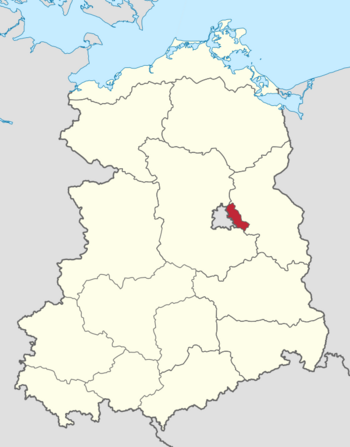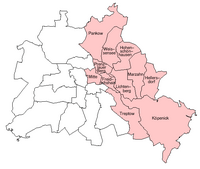East Berlin facts for kids
Quick facts for kids
East Berlin
Ost-Berlin
Berlin (Ost) Demokratischer Sektor von Berlin Berlin, Hauptstadt der DDR |
|||||||||||
|---|---|---|---|---|---|---|---|---|---|---|---|
| 1948–1990 | |||||||||||

East Berlin (red) within East Germany
|
|||||||||||
| Status | Capital of East Germany | ||||||||||
| First Secretary | |||||||||||
|
• 1948–1953
|
Hans Jendretzky | ||||||||||
|
• 1953–1957
|
Alfred Neumann | ||||||||||
|
• 1957–1959
|
Hans Kiefert | ||||||||||
| Lord Mayor | |||||||||||
|
• 1948–1967
|
Friedrich Ebert Jr. (SED) | ||||||||||
|
• 1967–1974
|
Herbert Fechner (SED) | ||||||||||
|
• 1974–1990
|
Erhard Krack (SED) | ||||||||||
|
• 1990
|
Ingrid Pankraz (PDS) | ||||||||||
|
• 1990
|
Christian Hartenhauer (PDS) | ||||||||||
|
• 1990–1991
|
Tino Schwierzina (SDP) | ||||||||||
|
• 1991
|
Thomas Krüger (SDP) | ||||||||||
| Historical era | Cold War | ||||||||||
|
• Establishment of East Germany
|
7 October 1948 | ||||||||||
| 3 October 1990 | |||||||||||
| Population | |||||||||||
|
• 1946
|
1,174,582 | ||||||||||
|
• 1961
|
1,055,283 | ||||||||||
|
• 1989
|
1,279,212 | ||||||||||
|
|||||||||||
| Today part of | Germany | ||||||||||
East Berlin (German: Ost-Berlin) was the capital city of East Germany (GDR) from 1949 to 1990. After World War II, Berlin was divided into four parts, or "sectors," by the countries that won the war: the United States, the United Kingdom, France, and the Soviet Union. East Berlin was the part controlled by the Soviet Union. The American, British, and French sectors together formed West Berlin.
For many years, from 1961 to 1989, East Berlin was separated from West Berlin by the famous Berlin Wall. Even though East Berlin was the capital of East Germany, some Western countries, like the United States, didn't officially agree with this. They still saw it as part of the Soviet-controlled area of Berlin. On October 3, 1990, East and West Berlin became one city again when Germany was officially reunited.
Contents
What was East Berlin?
After World War II ended in 1945, the winning countries (the Allies) decided to divide Germany and its capital, Berlin, into different areas. The United States, the United Kingdom, and the Soviet Union each got a part. They planned to manage Berlin together.
However, in 1948, the Soviet Union left this joint group. This led to Berlin being split into two main parts: the Soviet sector (East Berlin) and the Western sectors (West Berlin). When East Germany was created in 1949, it quickly declared East Berlin as its capital. Other communist countries recognized this claim.
Life in East Berlin
In 1948, the Soviet Union blocked all roads and railways leading to West Berlin. This event is known as the Berlin Blockade. People in East Berlin were not allowed to move to West Berlin. However, many East Germans tried to escape to West Berlin because of economic problems in East Germany.
To stop people from leaving, the East German government built the Berlin Wall in August 1961. Crossing the wall was very dangerous. Soldiers were trained to stop people who tried to escape illegally.
East Germany was a socialist country. Over time, Christian churches were allowed to operate more freely. In the 1970s, life improved for many East Berliners. Their wages went up, and they worked fewer hours.
East and West Recognition
The Soviet Union and other communist countries saw East Berlin as the capital of East Germany. But the Western Allies (the United States, United Kingdom, and France) never officially agreed that the East German government had the right to rule East Berlin. They still considered it part of the Soviet occupation zone.
Even so, in the 1970s, the Western Allies opened embassies in East Berlin. An embassy is like an official office for a country in another country. But they still avoided calling East Berlin the "capital" in their official documents. They used phrases like "seat of government" instead.
On October 3, 1990, East and West Germany, along with East and West Berlin, were reunited. This brought an end to East Berlin as a separate entity. The city held elections in December 1990. A single mayor was then chosen to lead the reunited city of Berlin.
East Berlin's Population History
East Berlin's population changed over the years. It reached its highest number in 1988, with about 1.28 million people. The lowest population was recorded in 1961, the year the Berlin Wall was built, with just under 1.06 million people. The numbers below come from East Germany's official statistics.
|
|
¹ Census
East Berlin Today
Since Germany reunited, the government has spent a lot of money to bring the two halves of Berlin back together. They worked to improve services and buildings in former East Berlin to match West Berlin's standards.
After reunification, the economy in East Germany faced challenges. Many factories closed down because they couldn't compete with West German companies. This led to many people losing their jobs. To help, West Germany sent a lot of money to East Germany. They even introduced a special tax called the "solidarity surcharge" to help pay for this rebuilding.
Even today, you can still see differences between the former East and West Berlins. East Berlin has a unique look, partly because more old buildings survived the war. Also, the buildings built in East Berlin often have a special style called "Socialist Classicism," which looks different from buildings in West Berlin.
Some streets and places in former East Berlin still have names that honor East German heroes, like Karl-Marx-Allee. However, many names were changed after reunification.
Another special symbol of former East Berlin is the Ampelmännchen. These are the little men on pedestrian traffic lights. They wear a fedora hat and are very popular. You can now even find them in some parts of former West Berlin.
Even 25 years after reunification, people from East and West Berlin sometimes still had noticeable differences, especially older generations. They even had slang terms for each other: an "Ossi" for someone from the East and a "Wessi" for someone from the West. Sometimes, these terms came with stereotypes, like an Ossi being seen as less ambitious, and a Wessi as arrogant.
Boroughs of East Berlin
When Germany reunited, East Berlin was made up of these areas, called boroughs:
- Friedrichshain
- Hellersdorf (added in 1986)
- Hohenschönhausen (added in 1985)
- Köpenick
- Lichtenberg
- Marzahn (added in 1979)
- Mitte
- Pankow
- Prenzlauer Berg
- Treptow
- Weißensee
Images for kids
-
Marx-Engels-Platz and the Palace of the Republic in East Berlin in the summer of 1989. The Fernsehturm (TV Tower) is visible in the background.
-
New Synagogue, Oranienburger Straße
-
Strausberger Platz with constructivism style building
-
Proletarian hero, Alexanderplatz
-
Gerhard Behrendt with Sandmännchen. The show was recorded in East Berlin.
See also
 In Spanish: Berlín Este para niños
In Spanish: Berlín Este para niños






















